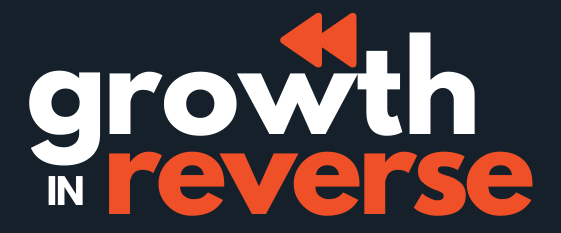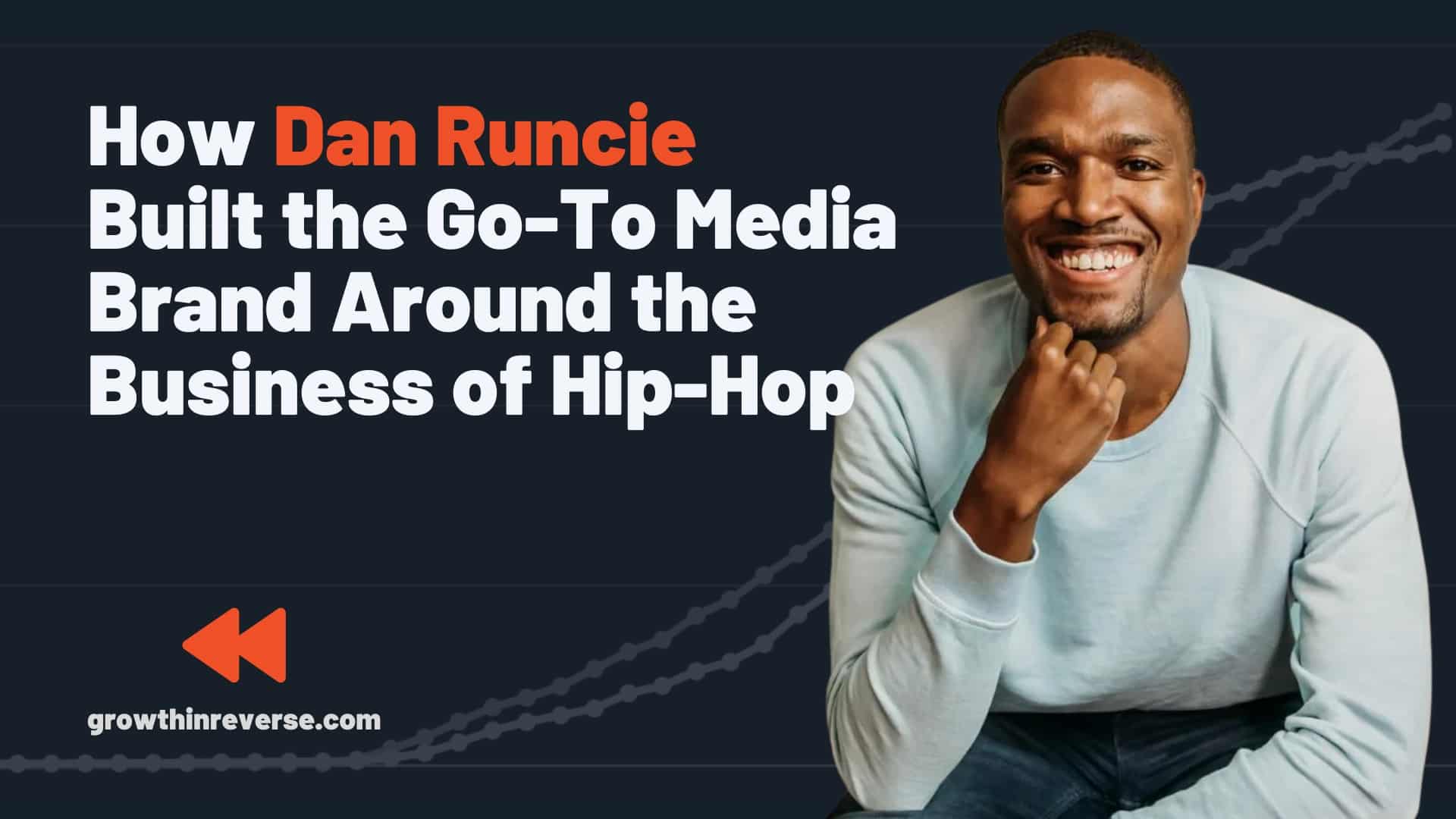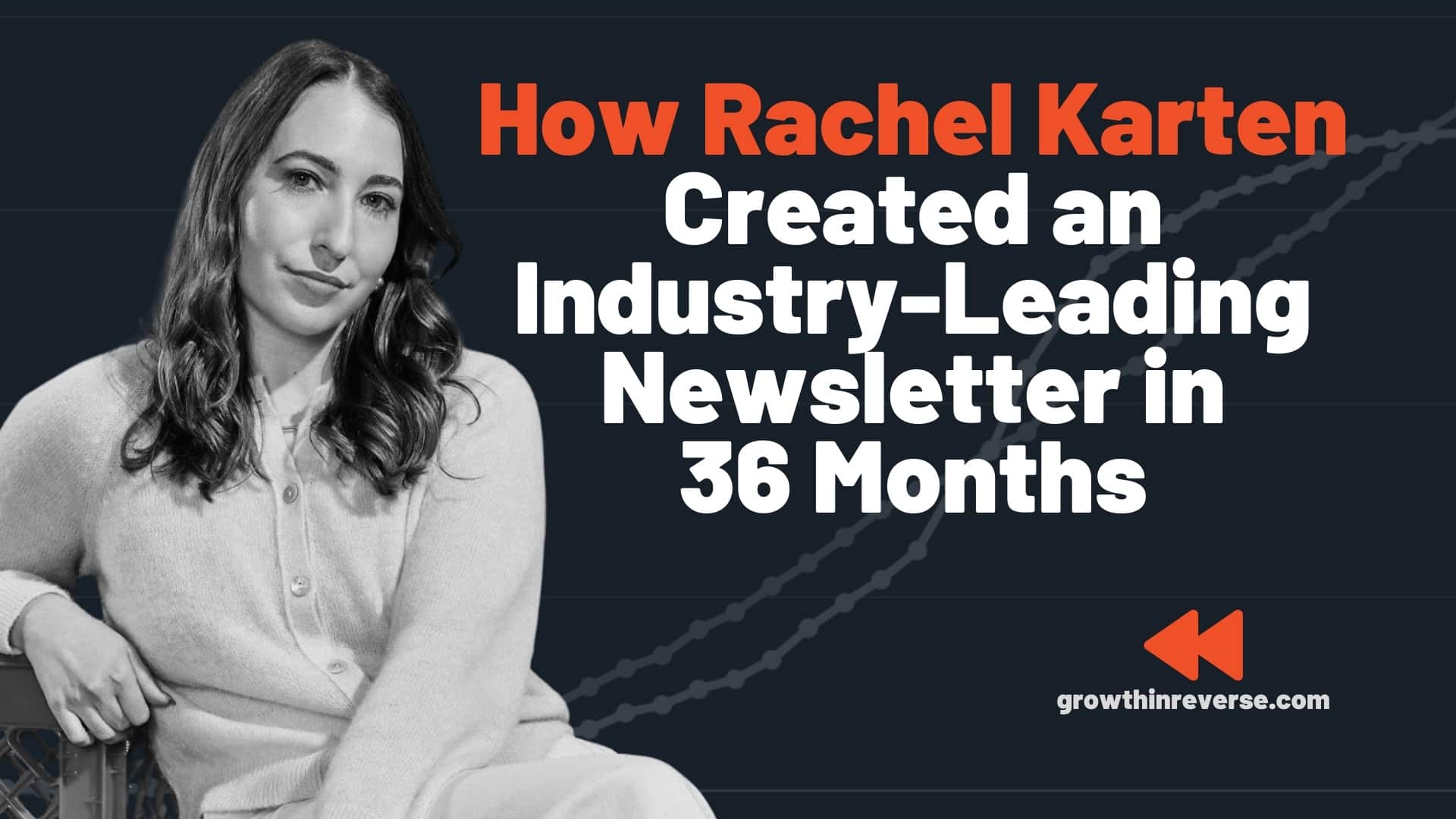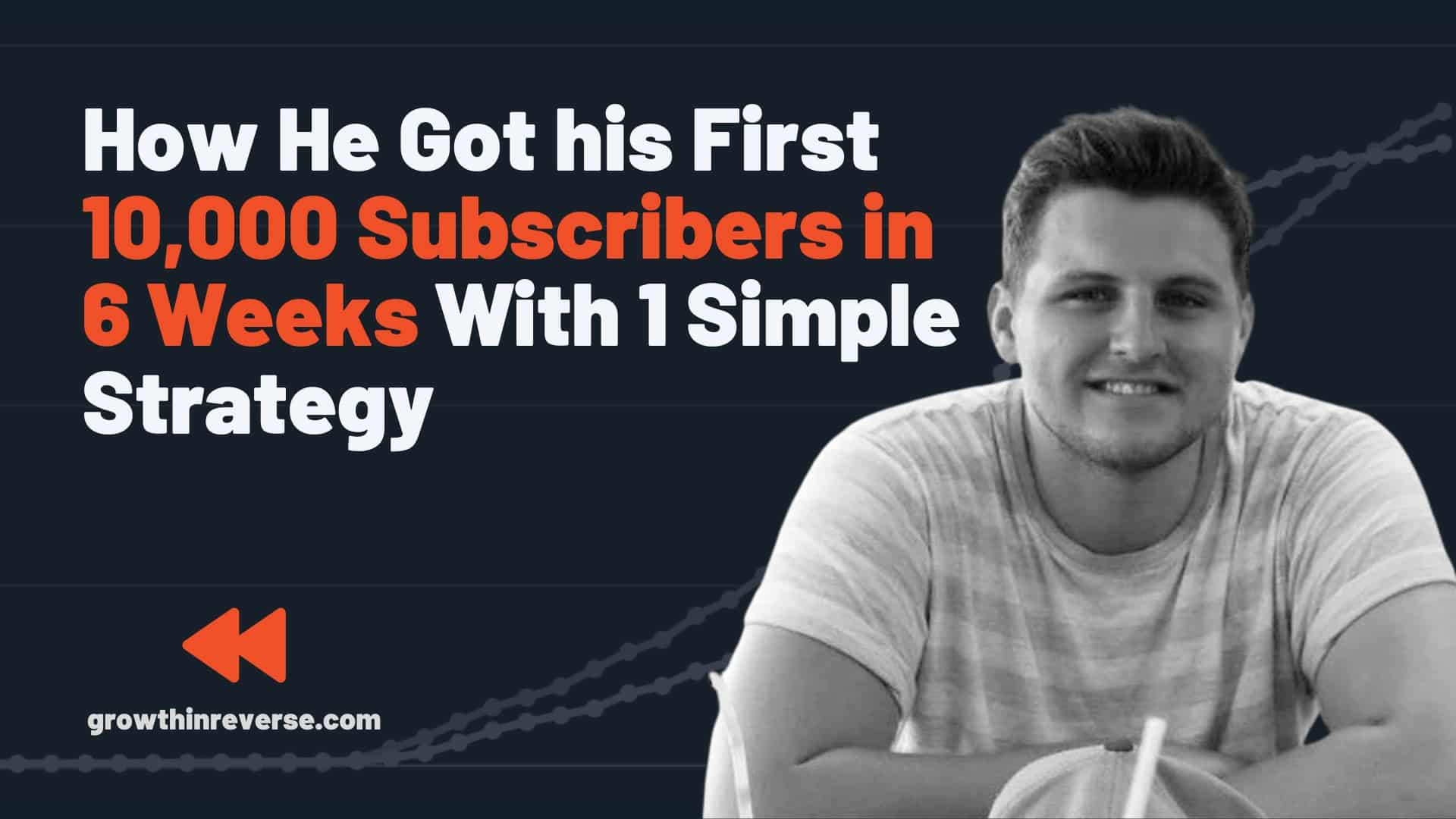Daniel Murray runs Marketing Millennials – a newsletter and podcast focused on marketing for the new age. And he knows his stuff.
Daniel has been able to grow multiple digital properties FAST:
- His LinkedIn page has over 100k followers
- The Marketing Millennials LinkedIn page has over 600k followers
- The email list has 92k subscribers
All of this growth has happened since he began posting on his personal LinkedIn in December of 2019.

Football Player Turned Marketer
Daniel played college football at the University of Cincinnati, a Division 1 school.
In an interview with Jay Clouse, Daniel said that while college might not have taught him a lot about marketing, he says that playing football taught him quite a bit, including:
- The importance of practice
- How to be consistent
- Hard work and competition
- How to stay calm under pressure
- The importance of teamwork
Taking after his mom who worked in marketing, he realized he wanted to pursue a career in marketing as well.
After college, he hit the ground running in the marketing scene. He took jobs where he could learn as much as possible from the people he was working for.
In late 2019, he heard Gary Vaynerchuk saying that LinkedIn had a lot of underpriced attention. Daniel wanted to test that theory, so he started posting on his personal LinkedIn page.
It took him a while to get traction.
How Daniel Murray Makes Money
This one is a little more challenging than past deep dives I’ve done. I have almost zero knowledge about what kind of income Daniel makes.
Daniel is part of WorkWeek, which is an overarching brand for creators.
From my understanding, creators under the WorkWeek brand get a salary and a portion of the revenue drive to the overarching brand.
According to Axios, they also “share cuts of revenue with Workweek across several business lines, including newsletter subscriptions to start, and eventually things like events and e-commerce.”
Marketing Besties
Daniel ran a LinkedIn growth community called Marketing Besties in November and December of 2022.
It was a 1:1 texting cohort that lasted for 2 weeks, and costed $299.

I have not seen this continue into 2023, so I’m wondering if it was a lot of work for him to be texted personally like that, or what happened.
The Growth Timeline Of Daniel Murray
Daniel started posting on his personal LinkedIn page in late 2019.
Around 12 months later, he had gotten to around 25-30k followers, and at that point, he created his company page for Marketing Millennials.
Within 4 months his company page had 25,000 followers. And the following year he cracked 250k followers on that company page.
In May of 2022, he started his newsletter, which now has almost 100k subscribers just 9 months later.

Compared to his LinkedIn company page growth, the other numbers don’t look quite as impressive.
Here is the same chart without the company page on there so you can visualize it better.

Twitter has recently become something Daniel’s been posting on, but the growth there has been slow and steady.
Daniel Murray’s Growth Levers
Of course, LinkedIn has been the platform that has driven a ton of this growth, but these are the mechanics of what helped him grow that audience:
1. LinkedIn Company pages. No one is talking about this for creators, so I had to include this one or else the deep dive would be a waste. I’ve broken down the main tips Daniel’s used to grow his page to over 600k followers.
2. Quantity over quality. You read that right. Daniel advocates for quantity over quality. While he’s not putting out bad content, the consistency of his posts has been a huge reason he’s grown so quickly.
3. Smart consumption. You need to consume content to create content. Period. This reframe he uses is really interesting.
4. Content/Audience Fit. This is one of the biggest mistakes people make online, and it can crush your growth momentum if you get this wrong.
Let’s dive into each one and see why they are so powerful.
1. Growing a LinkedIn Company Page
I can’t write this deep dive without including Daniel’s strategy for growing his LinkedIn pages. While it might be a little more challenging these days to grow to a massive size in just a few years, the reach on LinkedIn still seems to be huge.
Here are some tips and ideas I’ve picked up after researching how he grew his company page to over 600k:
Make sure your audience is actually on LinkedIn
I made this step 0 because you really need to make sure all of this work isn’t going to be a waste.
If your ideal clients are plumbers, move along and use another platform.
Grow a personal page to 25k followers.
I put this here as partly a joke, but it’s a big part of how he grew.
Having this initial traction allowed him to scale the company page to the same size in just a few months.
While I don’t think this is a necessary step, I had to include it because it really jumpstarted his growth.
Some of the tips Daniel used to grow his personal page include:
- Posting at least once a day
- Comment on other posts with something valuable (not “nice!” or “great post!”)
- Connect with people in your niche who are active
- Find the big creators in your niche
- Look at the comments below their recent posts
- Connect with 20 of those people each day and include a message like “Hey, I saw you commented on Daniel’s post. I’m looking to connect with other active people in the marketing niche.”
- Comment back on all comments on your post for at least the first hour
Get super specific about your niche
When Daniel started he was posting about all kinds of topics – business, cooking, highlights from his job, etc.
That’s why it took him around 6 months to gain any meaningful traction on LinkedIn. He didn’t even hit 3,000 followers until that point.
After that, he realized that the algorithm shows people your content based on what they think will get likes. If you post about your company, they’re going to show people who might be interested.
This is why it’s critical to hone in on a niche early on.
Make content your audience wants
I mention this later in the content/market fit section, but it’s worth repeating.
You need to make content that the audience wants. Not sure what kind of content they want? Here are some ways you can find topics:
- Look for what those people ask on Quora, Twitter, Google, and YouTube
- Go to top content creators and see what topics they are posting about
- Go to those creator’s posts and read through the comments section
- Keep a running list of questions your audience asks you
- Go through bestselling books in your niche and look at the table of contents
- Repurpose old blog posts on your website if you have them
You can honestly find a ton of ideas just in the creator’s posts and in their comments section.
Post more than you think you should
With personal LinkedIn pages, you will get throttled if you post too often. But with company pages, that doesn’t seem to happen.
Daniel says the game with company pages on LinkedIn is posting often and posting super relevant content.
Make the content about your audience. Never post links to your company’s website or anything about your company. All content should be about the audience.
The Marketing Millennials page seems to be posting between 2-4x per day.
Double-Down on what’s working
Once you’ve been creating content for a while, you’ll have a repository of tweets and LinkedIn posts that have performed much better than others.
You can repackage those into a different format (longer vs shorter, images, memes, etc) and rerun that content. If it does well again, keep it in your repository.
On the same token, you can take a tweet that did well and repost it on LinkedIn, or other platforms.
Repurpose & Repost
When something works, why would you quit running it?
Think of it like a marketer running ads for a client. If the ads are performing super well and driving the results you want, you’re not going to stop running them.
You want to squeeze all of the juice out of those ads until they stop working.
Daniel applies this same mentality to content he’s created in the past. If it got him 50,000 likes a few months ago, why not repurpose it and run it again?
He has a similar mentality to the way Justin Welsh reposts content after a few months. And honestly, this is a common tactic among a lot of the bigger names.
Add a little laughter into their day
Daniel noticed that meme pages were going absolutely bonkers on Instagram and Twitter. But no one was doing that on LinkedIn.
People respond really well to these memes.
And from what I can tell if the post gets enough engagements, he will go back and add a link to the newsletter.
You can see the second line under their caption is driving them back to the newsletter. But not all of their posts have this – only the ones with more than 100 likes seem to.
The reason for this is that LinkedIn throttles the reach of posts with a link to an external site. So if you wait until the post already has some traction to add the link, you’re less likely to interfere with that reach.
Super smart.

Post other people’s content (with attribution)
Daniel also posts content from other creators that he knows his audience will like.
He says that only 1 person has ever asked him to take it down, and most people actually send him their content to run on his page.
They get tagged so their page gets some visibility, but it’s also providing value for his audience.
Here’s one from a few days ago:
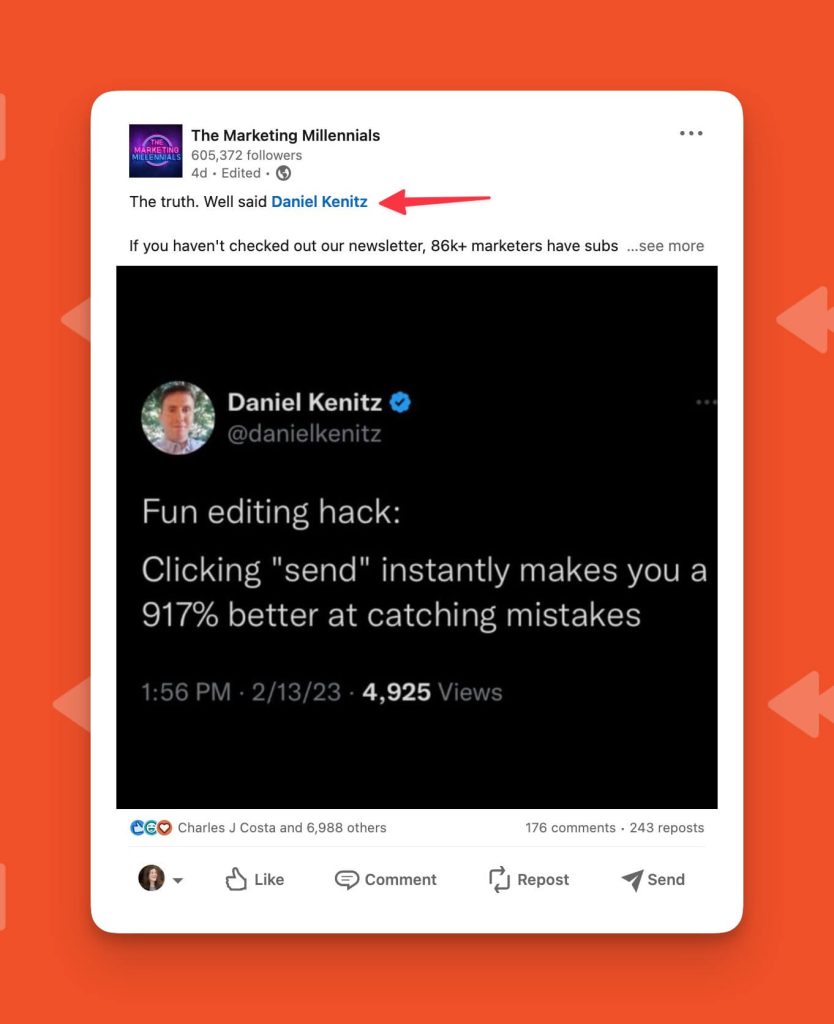
Most people are thankful he’s reposting their content.
Why This Works
LinkedIn gets paid when companies post jobs and run ads on the platform.
It seems that they are giving company pages more reach because they want to incentivize them to build a following on that platform.
If a company is on the platform regularly, it’ll be more likely to post jobs and run ads.
2. Quantity Over Quality
Lots of “influencers” seem to be shouting that quality is better than quantity. And if you just put out super high-quality content, you’re going to grow.
But that doesn’t work for everyone.
Daniel approaches this in a different way, and advocates for quantity over quality.
He isn’t saying to put out crappy content by any means. But he is in the camp of people that say you need to put in the reps.
While he’s not putting out garbage content, the consistency of his posts has been a huge reason he’s grown so quickly.

He believes that quantity leads to quality. And I have to agree in this context.
The more you do something, the better you’ll get at it.
And in the case of building an audience online, the better you’ll understand what resonates with your audience.
If you think about some of the people who have grown really fast on Twitter, they’re consistent in putting out content.
- Nathan Baugh wrote daily threads for a while
- Sahil Bloom wrote 2-3 threads a week
- Justin Welsh has written on LinkedIn almost every day for 4 years
Putting out more content leads to better quality, as long as you’re going back and analyzing it.
Practice Leads to Championships
In one of the podcasts I listened to in doing research for this, a lightbulb went off for me and I want to share it with you.
As I mentioned earlier, Daniel was a football player, and he makes this really amazing analogy between football and business in an interview with Amelia Sordell.
He compares the consistency of posting every day to the consistency of having to practice to get good at a sport.
Practice leads to championships, in the same way, that posting consistently every day leads you to get those big wins.
He says that practice is always harder than the real game.
The real game is the people you meet and those big moments and chances to go viral. But you’ll never get those opportunities or build those relationships if you’re not practicing.
Practice is what leads to those championship moments.
When you get a viral post, it’s because you did all those little things that warmed you up.
– Daniel Murray
But as he said, it’s not easy. Sometimes practice is really hard and doesn’t seem to be helping. But it usually is helping in a way you might not be able to see quite yet.
You have to stay consistent even when you get zero likes.
The days when you get zero likes are like the hard practices you have in sports.
But you have to have those hard moments to enjoy those championship moments.

Consistency
Consistency for Daniel isn’t about posting just to check the box.
Marketing is by definition a consistency game.
When you’re consistent, people will see your posts regularly. They might not remember every single post, but they’ll remember that YOU showed up in their feed.
It takes time to convert attention into intention.
Intention comes from trust. Trust comes from expertise, consistency, and education.
Daniel Murray
3. Smart Consumption
Lots of influencers often say that you need to be a creator, not a consumer. Hearing this used to make me feel like I was doing it wrong.
It’s super refreshing to hear another take on this though.
Yes, You Should Be Consuming Content
You need to be consuming content to be able to create good content. Period.
There are reasons why most writers read a lot of books.
And why movie directors watch tons of movies.
If you’re not paying attention to what’s working, or what ideas resonate better online, it’s going to be quite hard to build an audience.
Sure, you might be able to do it, but it’s going to be hard.
Of course, everything comes with a caveat.
The things you’re consuming need to be the right things too.
While it’s ideal to consume things, you want to consume the right things as well.
Reading the news every day if you’re not creating around the topics in the news is not a great idea.
4. Content/Market Fit
This concept is so important, but I feel like it gets bucketed in with all the other foundational stuff and doesn’t get talked about much.
So what’s the concept of content to audience fit?
You want to be posting the content your ideal customer is looking for. Seems simple, right? It trips up a lot of people, so let’s look at an example.
Web Designer Example
Let’s say you’re a web designer who helps dentists and you want to start posting on social media to get more clients.
You might think you should start posting “how to” type content, and information that would help someone with their website.
Great idea, right? Wrong.
Do you know who that type of content will attract? Other web designers.
Dentists don’t care about how to fix their website – they want to hire you to do that.
By posting that type of content, you’re going to attract the wrong audience on social media.
The algorithm is going to show your stuff to people who are interested in that content, which is sadly not your ideal customer.
You won’t end up getting any clients, and then you’ll blame social for “not working.”
What to Do Instead
Instead of attracting the wrong people, sit down and figure out what your ideal clients do want to read.
Maybe you could instead write about HOW a website can bring in more customers for them. Or even curate the news for that industry.
How You Can Replicate Daniel’s Growth
Here are some ways you can replicate Daniel’s success online.
Set Input Based Goals
Practice leads to championships. But sometimes practice can be really hard.
What I try to do is create “input-based goals” where if I complete the task then it’s a win. Even if what I post gets terrible feedback.
You can’t control how many likes something will get (especially in the beginning).
Focus on just creating 10 pieces of content this week instead of getting 100 likes. You’ll save yourself from a lot of negative feelings.
Remember that marketing is a consistency game.
Build a LinkedIn Company Page
If your social medium of choice is LinkedIn, it might be time to try your hand at a company page.
- Post something you’ve created 1x per day
- Re-post someone else’s content (with attribution) 1-2x per day
- Comment on 10 other posts
- Connect with 20 other people per day
- Comment back on all comments you get on your posts
Using those input-based goals will allow you to keep building on that page without being too obsessed with the outcomes you’ll see upfront.
Building a company page, or any social profile takes time, but once you hit a point of momentum it will start to snowball and get a little easier.
Make Sure You Have Content/Market Fit
These are the concepts you hear a million times and have ignored.
Spend an hour and really think about what kind of content your ideal client or customer wants to read. Write down a few ideas.
Put yourself in their shoes and really think about their day-to-day.
You can do some competitive research and see what kind of content other people in your niche are creating. Are they getting a ton of engagement on their posts?
Keep in mind that just because they are doing it, doesn’t mean it’s the right content.
This might be the most impactful 30-60 minutes you’ll spend this week.
